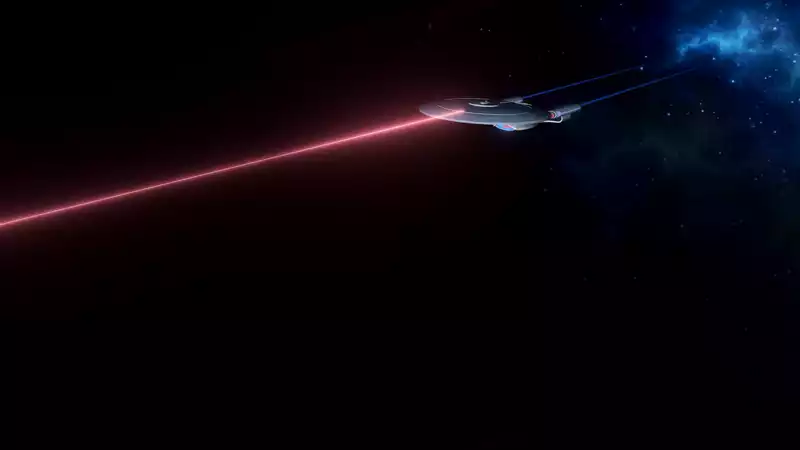I am warning you at the beginning of this review: we are going to spend a lot of time at the beginning of this review talking about another game. I don't usually do this, but as you might guess from the screenshots, "Infinite" is based on the "Stellaris" chassis, but with a Star Trek twist. Think of it as Napoleon: Total War to Stellaris' Empire: a more focused, narrative spin-off from the larger, sprawling game.
The game is set in the Next Generation/Deep Space Nine era (actually beginning with the Romulan attack on Khitomer, in which Worf's family was killed) and depicts the four superpowers-the Federation, Klingons, Romulans, and Cardassians-in constant competition The game is depicted as if the four superpowers are in constant competition. In my game, for example, early decisions brought the Federation and Klingons closer together, and the Romulans and Cardassians immediately countered by forming a rival alliance to thwart the threat.
Unlike Stellaris, Infinite is semi-random: the four major powers clash almost identically in the center of the map each game, while the rest of the galaxy is filled with randomly placed "minor powers." Thus, a classic Federation member such as Trill could spawn on the other side of the galaxy and be invaded by Romulans. It is similar to joining a game of "Stellaris" about a third of the way through after a large power block has been formed. In most cases this works surprisingly well, but there are some oddities. For example, if you are playing as the Federals, you are prompted to colonize the uninhabited planet Denobula. I know what you mean, Nimble Giant, there are times when I wish the Enterprise never existed, too. [Star Trek: Infinite] is much more of a Federation fantasy than Stellaris. Here, it can expand purely through diplomacy, endearing itself to minor races and inviting them one by one. The Romulans set up a puppet government, and the Cardassians use something similar to the Stellaris overload system. The Klingons only invade people and don't really do anything subtle.
One of the other major changes from Stellaris will be familiar to players of other Paradox games. Events will be triggered, ranging from the exciting objective of "bringing Bajor into the Federation" to the more mundane objective of "surveying 10 star systems. Some of these events follow classic Trek stories, while others present compelling "what if" moments, such as the reunification of Romulan and Vulcan. These are as much about steering the style of play as they are about reaping the rewards, and I enjoyed them immensely.
The best of these mission chains is the Enterprise itself. Complete the first step and you have an all-purpose supership equally adept at science, warfare, and diplomacy. Sending the Enterprise out on various jobs rewards the next generation of crew members, who give you general Imperial bonuses or physically appear as recruitable leaders. Other major and minor Trek characters may also appear in this way. Namely, completely organically, the Enterprise has been rescued by Benjamin Sisko, commanding the Voyagers' fleet, in a situation where the Enterprise is bravely holding the line against an unstoppable Borg sphere.
At this point, I have to talk about the targ in the room: why should I pay for the game when Stellaris already has a Star Trek mod and the mod is free?" Stellaris' New Horizons mod is a Star Trek epic that encompasses the entire history and every faction in the galaxy, but Infinite focuses on the Alpha and Beta Quadrants of the Next Generation era, and frankly, I think that's the way to go. This means, for example, that the Borg are more like the dreaded invaders that come out of nowhere in the show than the other player factions. Also, paradoxically, if you don't have the full Stellaris DLC, this is cheaper.
More than any mod, what Infinite should have is refinement, and while it feels less inconvenient than New Horizons, it still has more problems than necessary at launch. The "silent alarm" notification is apparently silent, there is a strange bug that narrates that a character has died every five minutes, and there are two Rikers. To be fair, that last one happened at the show as well.
All of this, and a lot of direct porting from Stellaris, makes Infinite feel a bit unfinished; I don't mind that Nimble Giant didn't specifically change the planet-building interface, but as a famously post-capitalist Federation, energy I feel that credits should not be exchanged for alloys. I am also disappointed in the lack of interaction with pre-FTL civilizations, and it might have been nice to have one or two dilemmas in the Prime Directive. In the end, I stopped playing well before the victory condition, which is common even in Stellaris, which I have played for hundreds of hours.
However, at the end of every review, I always ask myself, "Now that I'm not getting paid, do I still want to play this game some more?" and the answer here is yes. I really want to do the reintegration story arc, I want to see if I can evacuate the Romulans before the sun explodes this time (sorry guys), and I want to actually get the Enterprise-E before Jean-Luc Picard dies of old age.
I won't mark what the game could be, but I certainly hope that "Infinite" gets the same post-launch support as its big brother. It would be fascinating (as a captain) to see how these two games grow and influence each other over the years. When that happens, it will be the best of both worlds.
.

Comments